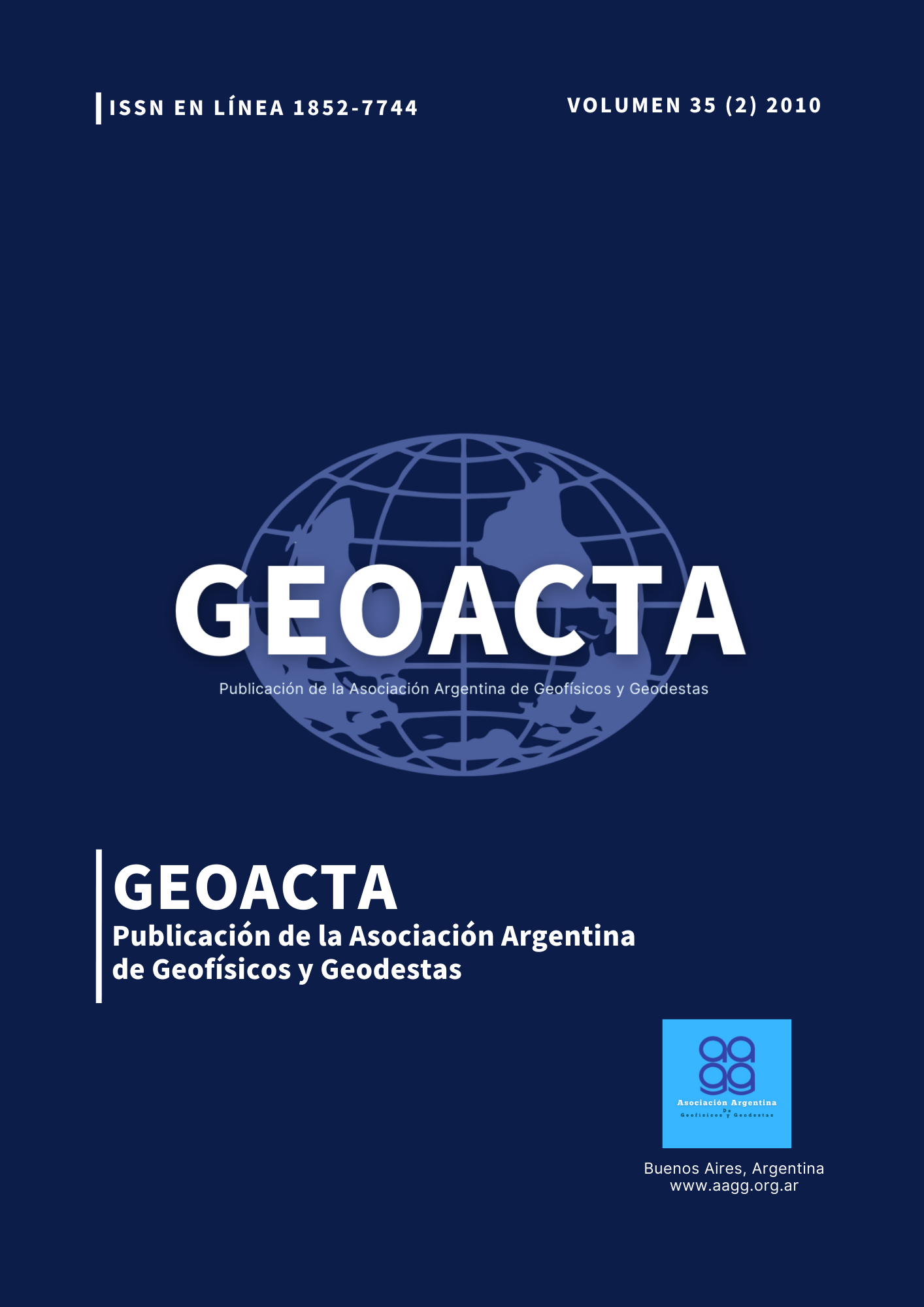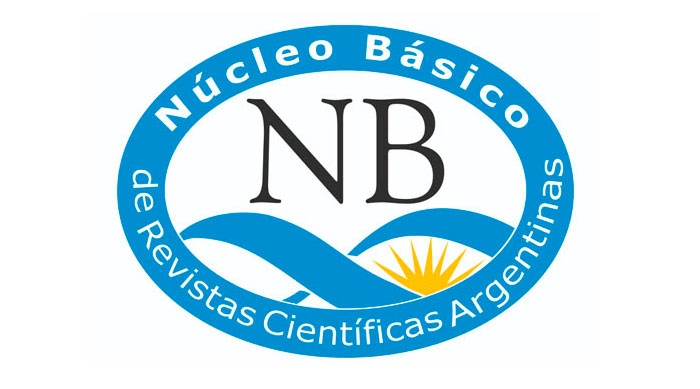Respuesta de geófonos a campos electromagnéticos
Keywords:
electroseismic, Maxwell equations, Biot equations, poro-viscoelastic mediumAbstract
Electro-osmosis in saturated porous media is the physical phenomenon in which an electrical potential variation gives rise to fluid flow. The reciprocal phenomenon, called electro-filtration effect, is an electrical charge flux originated by pressure gradients in the pore fluid. The quotient between electrical potential and pressure gradient represents the electrokinetic coupling coefficient. In 1999 a proof field was performed, where seismic waves were generated by electromagnetic source. In this work it is explained why happen these phenomena. The equations that govern the coupled seismic and electromagnetic wavefields are presented and the transport coefficients (electrical conductivity, dynamic permeability and electrokinetic coupling coefficient) are analyzed. Some assumptions on the model allow solve a simplified set of equations where Maxwell's equations are decoupled from Biot's equations. For the Maxwell's equations it is possible to separate the electromagnetic fields in primary and secondary parts. The former can be found analytically, while to find the latter a numerical procedure is employed. Dissipative effects in porous media can be included by using complex viscoelastic moduli in space-frequency domain. Also, it is important notice that pressure gradients in the pore fluid are correctly represented if the grid points are calculated using diffusive skin depth of the Biot slow wave. Numerical examples illustrate the capabilities of the modeling for detecting reservoir fluid contacts.
Downloads
References
Biot M. A., 1956a. Theory of propagation of elastic waves in a fluid-saturated porous solid. I. Low frequency range. J. Acoust. Soc. Amer., 28: 168-171.
Biot M. A., 1956b. Theory of propagation of elastic waves in a fluid-saturated porous solid. II. High frequency range. J. Acoust. Soc. Amer., 28: 179-191.
Biot M. A., 1962. Mechanics of deformation and acoustic propagation in porous media. J. Appl. Phys., 33: 1482-1498.
Blau L. W. y Statham L., 1936. Method and apparatus for seismic-electric prospecting, US Patent No 2: 054-067.
Butler K. E., Russell R. D., Kepic A. W. y Maxwell M., 1996. Measurement of the seismoelectric response from a shallow boundary, Geophysics, 61: 1769-1996.
Gassmann F., 1951. Über die elastizität poröser medien (On the elasticity of porous media). Vierteljahrsschrift der Naturforschenden Gessellschaft in Zurich, 96: 1-23.
Gauzellino P. M., Zyserman F. I. y Santos J. E., 2001. Análisis del comportamiento de algoritmos paralelos de elementos finitos con descomposición de dominio en aplicaciones geofísicas, Mecánica Computacional, 20: 474-481.
Gauzellino P. M., Zyserman F. I. y Santos J. E., 2009. Nonconforming element methods for the three dimensional Helmholtz equation: iterative domian decomposition or global solution ?, J. Comp. Acoustic, 17 (2) (en prensa).
Haines S. H. y Pride S. R., 2006. Seismoelectric numerical modeling on a grid, Geophysics, 71 (6): 57-65.
Han Q. y Z. Wang Z., 2001. Time-domain simulation of SH-wave-induced electromagnetic field in heterogeneous porous media: A fast finite-element algorithm, 66 (2): 448-461.
Ivanov A., 1939. Effect of electrization of earth layers by elastic waves passing through them, Comptes Rendus (Doklady) de l’Academie des Sciences de L’URRS, 24:42-45.
Johnson D. L., Koplik J. y Dashen R.1987. Theory of dynamic permeability and tortuosity in fluidsaturated porous media,J. Fluid Mechanics, 176: 379-402.
Liu H. P., Anderson D. L. y Kanamori H., 1976. Velocity dispersion due to anelasticity; implications for seismology and mantle composition, Geophys. J. R. Astr. Soc., l47: 41-58.
Long L. T. y Rivers W. K., 1975. Field measurements of the electroseismic response, Geophysics, 40 (2): 233-245.
Lorne B., Perrier F. y Avouac J., 1999. Streaming Potential measurements 1. Properties of the electrical double layer from crushed rock samples, Journal Geophysical Research, 104: 17857- 17877.
Maxwell M., Russell R. D., Kepic A. W. y Butler K. E., 1992. Electromagnetic responses from seismically excited targets B: non-piezoelectric phenomena, Expl. Geophys., 23: 201-208.
Pain C., Saunders J., Worthington M., Singer J., Stuart-Bruges W., Mason G. y Goddard A., 2005. A mixed finite-element method for solving the poroelatic Biot equations with electrokinetic coupling, Geophys. J. Int., 160: 592-608.
Pride S. R. y Morgan F., 1991. Electrokinetic dissipation induced by seismic waves, Geophysics, 56: 914-925
Pride S. R., 1994. Governing equations for the coupled electromagnetics and acoustics of porous media, Physical Review B, 50: 15678-15696.
Pride S. y Haartsen M., 1996. Electroseismic wave properties, J. Acoust. Soc. Amer., 100: 1301-1315.
Pride S. y Garambois S., 2001. The role of Biot slow waves in electroseismic wave phenomena, J. Acoust. Soc. Amer., 111: 697-706.
Revil A., Schwaeger H., Cathles {III} L. M. y Manhardt P., 1999. Streaming potential in porous media, 2. Theory and application to geothermal systems, Journal Geophysical Research, 104: 20033- 20048.
Santos J. E., 1998. Global and domain-decomposed mixed methods for the solution of Maxwell’s equation with application to magnetotellurics, Num. Meth. For Partial Diff. Equations, 14: 263-280.
Santos J. E. y Sheen D., 2007. Finite element methods for the simulation of waves in composite saturated poroviscoelastic materials, SIAM, J. Numer. Anal., 45 (1): 389-420.
Thompson R. R., 1939. A note on the seismic-electric effect. Geophysics, 4: 102-105.
Thompson A. H. y Gist G., 1993. Geophysical applications of electrokinetic conversion, The Leading Edge, 12: 1169-1173.
Thompson A. H. y Gist G., 1999. Geophysical prospecting. US Patent No 5: 877-995.
Thompson A. H., 2005. Electromagnetic-to-seismic conversion: Successful developments suggest viable applications in exploration and production. 75th SEG Annual Meeting Expanded Abstracts, SEG, Houston, USA: 554.
Thompson A. H., Hornbostel S., Burns J., Murray T., Raschje R., Wride J., McCammon P., Sumner J., Haake G., Bixby M., Ross W., White B. S., Zhou M. y Peczak P, 2007. Field tests of electroseismic hydrocarbon detection, Geophysics, 72 (1): N1-N9.
White B. S., 2005. Asymptotic theory of electroseismic prospecting, SIAM J. Appl. Math., 65 (4): 1443-1462.
White B. S. y Zhou M., 2006. Electroseismic prospecting in layered media, SIAM J. Appl. Math.,67 (1): 69-98.
Zyserman F. I., Guarracino L. y Santos J. E., 1999. A hybridized mixed finite element domain decomposed method for two-dimensional magnetotelluric modelling, Earth, Planets and Space, 51: 297-306.
Zyserman F. I., Gauzellino P. M. y Santos, J. E., 2003. Dispersion analysis of a non-conforming finite element method for the Helmholtz and elastodynamic equations, Int. J. Numer. Meth. Engng., 58: 1381-1395.
Zyserman F. I. y Gauzellino P. M., 2005. Dispersion analysis of a nonconforming finite element method for the three dimensional scalar and elastic wave equations, Finite elements in analysis and design, 41: 1309-1326.
Zyserman F. I., Gauzellino P. M. y Santos, J. E., 2009. Finite element modeling of SHTE and PSVTM electroseismic, CCAM-2009-02-MATH, http://CCAM.math.purdue.edu/preprints
Downloads
Published
How to Cite
Issue
Section
License
Copyright (c) 2010 Patricia M. Gauzellino, Fabio I. Zyserman, Federico G. E. Späth

This work is licensed under a Creative Commons Attribution-NonCommercial-ShareAlike 4.0 International License.
Starting in 2022 (Vol. 43 number 2) articles will be published in the journal under a Creative Commons Attribution-NonCommercial-ShareAlike 4.0 International license (CC BY-NC-SA 4.0)
According to these terms, the material can be shared (copied and redistributed in any medium or format) and adapted (remixed, transformed and created from the material another work), provided that a) the authorship and the original source of its publication (journal and URL of the work), b) is not used for commercial purposes and c) the same license terms are maintained.
Prior to this date the articles were published in the journal under a Creative Commons Attribution license (CC BY)
In both cases, the acceptance of the originals by the journal implies the non-exclusive assignment of the economic rights of the authors in favor of the editor, who allows reuse, after editing (postprint), under the license that corresponds according to the edition.
Such assignment means, on the one hand, that after its publication (postprint) in the GEOACTA Magazine of the Association of Geophysicists and Geodesists, the authors can publish their work in any language, medium and format (in such cases, it is requested that it be recorded that the material was originally published in this journal); on the other, the authorization of the authors for the work to be harvested by SEDICI, the institutional repository of the National University of La Plata, and to be disseminated in the databases that the editorial team considers appropriate to increase visibility. of the publication and its authors.
Likewise, the journal encourages the authors so that after their publication in the Journal of the Association of Geophysicists and Geodesists, they deposit their productions in other institutional and thematic repositories, under the principle that offering society scientific production and Unrestricted academic scholarship contributes to a greater exchange of global knowledge.
















